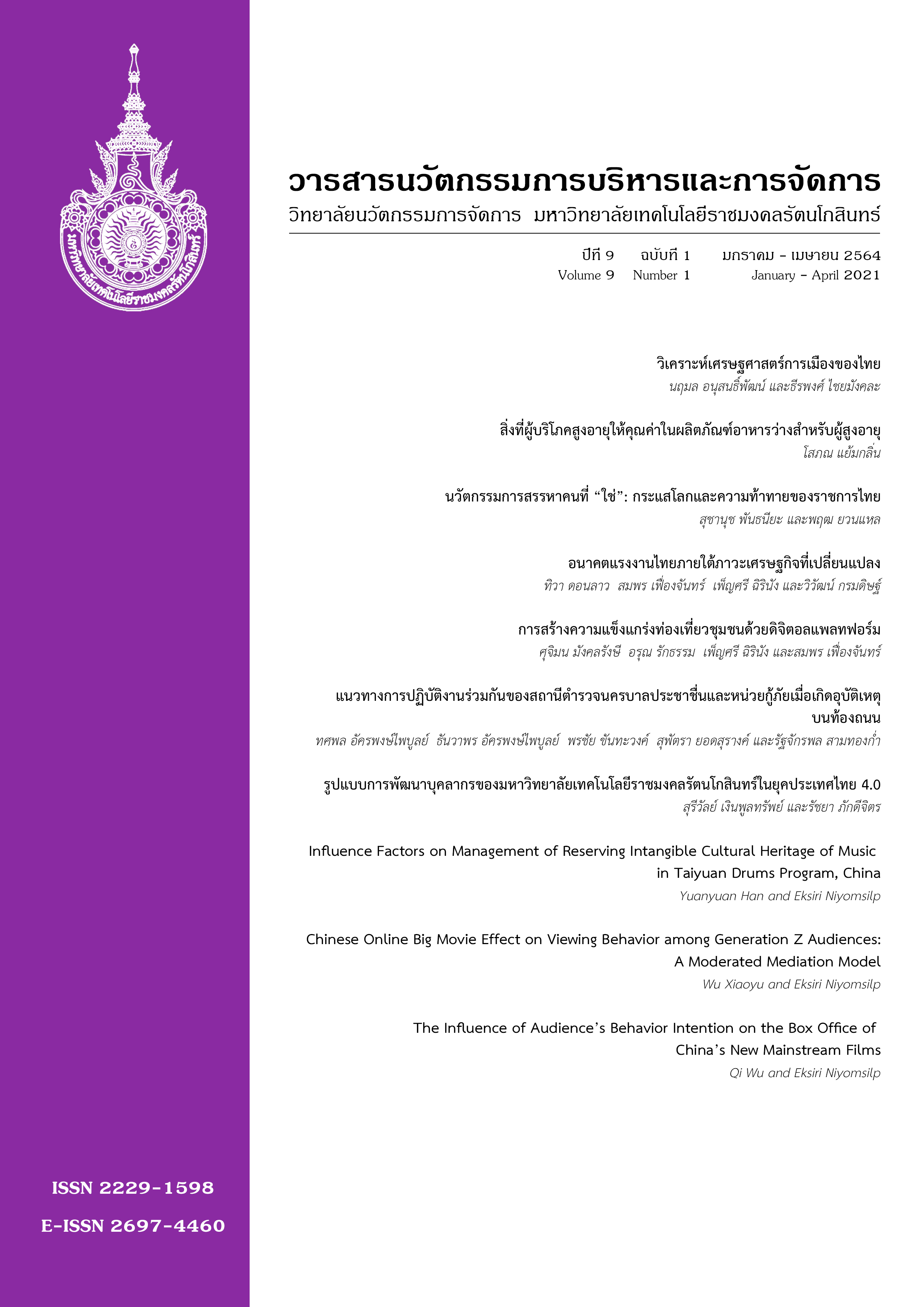สิ่งที่ผู้บริโภคสูงอายุให้คุณค่าในผลิตภัณฑ์อาหารว่างสำหรับผู้สูงอายุ
Main Article Content
บทคัดย่อ
ผู้สูงอายุเป็นกลุ่มผู้บริโภคที่ธุรกิจอาหารทานเล่นให้ความสนใจผลิตสินค้าและบริการให้มากขึ้น อย่างไรก็ตามธุรกิจยากที่จะประสบความสำเร็จหากไม่สามารถเข้าใจผู้บริโภคอย่างแท้จริง งานวิจัยฉบับนี้จึงทำขึ้นเพื่อศึกษาสิ่งที่ผู้สูงอายุให้คุณค่าในสินค้าอาหารทานเล่นโดยด้วยแผนภาพการออกแบบคุณค่าโดยใช้กระบวนการวิจัยเชิงคุณภาพ ด้วยการสัมภาษณ์เชิงลึกกับผู้สูงอายุจำนวน 30 คนและนำข้อมูลมาวิเคราะห์ด้วยกระบวนการวิเคราะห์ข้อมูลเชิงคุณภาพโดยใช้วิธีการวิเคราะห์เนื้อหา
ผลจากศึกษาทำให้ทราบถึงสิ่งที่ผู้สูงอายุให้คุณค่าสำหรับงานที่ผู้สูงอายุต้องการทำให้สำเร็จ โดยพบว่าผู้สูงอายุให้ความสำคัญกับงานด้านอารมณ์ เช่น ทานอาหารเพราะรู้สึกได้ย้อนยุคสมัย มากกว่างานตามหน้าที่ของอาหารทานเล่น เช่น เพื่อคลายความหิว เพื่อเสริมมื้อหลัก เป็นต้น นอกจากนี้สิ่งที่ผู้สูงอายุยังไม่ได้รับความสะดวกสบายเป็นประเด็นเกี่ยวกับปัญหาความกังวลด้านสุขภาพและความกังวลเรื่องโรคประจำตัว และสิ่งที่ผู้บริโภคสูงอายุมีความคาดหวังในทางบวกในอาหารทานเล่น เช่น มีความปลอดภัย และรสชาติอร่อย กลืนง่ายไม่ติดคอ ขนาดเหมาะทานครั้งเดียว เป็นต้น
งานวิจัยนี้เป็นงานวิจัยเพียงไม่กี่ฉบับที่ได้ศึกษาสิ่งที่ผู้สูงอายุเชิงลึกด้วยการใช้เครื่องมือการออกแบบคุณค่า ซึ่งผู้ประกอบการอาหารทานเล่นผู้สูงอายุสามารถนำผลวิจัยที่ได้ไปประยุกต์ใช้ในการออกแบบนวัตกรรมสินค้าและบริการให้สอดคล้องกับสิ่งที่ผู้สูงอายุให้คุณค่าได้อย่างแท้จริง โดยเฉพาะการที่ผู้สูงอายุให้ความสำคัญกับงานด้านอารมณ์ของอาหารทานเล่นมากกว่างานตามหน้าที่
Article Details
ข้อความและบทความในวารสารนวัตกรรมการบริหารและการจัดการ เป็นแนวคิดของผู้เขียน ไม่ใช่ความคิดเห็นและความรับผิดชอบของคณะผู้จัดทำ บรรณาธิการ กองบรรณาธิการ วิทยาลัยนวัตกรรมการจัดการ และมหาวิทยาลัยเทคโนโลยีราชมงคลรัตนโกสินทร์
ข้อความ ข้อมูล เนื้อหา รูปภาพ ฯลฯ ที่ได้รับการีพิมพ์ในวารสารนวัตกรรมการบริหารและการจัดการ ถือเป็นลิขสิทธิ์ของวารสารนวัตกรรมการบริหารและการจัดการ หากบุคคลใดหรือหน่วยงานใดต้องการนำทั้งหมดหรือส่วนหนึ่งส่วนใดไปเผยแพร่ต่อหรือกระทำการใดๆ จะต้องได้รับอนุญาติเป็นลายลักษณ์อักษรจากวารสารนวัตกรรมการบริหารและการจัดการก่อนเท่านั้น
เอกสารอ้างอิง
พีรพัศ อึ้งประเสริฐ, ประพิณวดี ศิริศุภลักษณ์, & สันติ แสงเลิศไสว. (2561). คุณลักษณะอาหารสำหรับผู้สูงอายุในกรุงเทพมหานคร ฯ. เอกสารประชุมวิชาการและนำเสนอผลงานวิชาการระดับชาติ UTCC Academic Day ครั้งที่ 2, 736 – 747. เข้าถึงจาก: https://scholar.utcc.ac.th/handle/6626976254/3836
วิทยาลัยการจัดการ มหาวิทยาลัยมหิดล. (2561). อาวุโส โซไซตี้ (AWUSO Society) 4.0 แก่แต่วัย หัวใจยังเก๋า. เข้าถึงจาก: https://www.facebook.com/AWUSOSOCIETY/
สุพรรณี พฤกษา, และสุวรีย์ ศรีปูณะ. (2561). พฤติกรรมการบริโภคอาหารของผู้สูงอายุที่มีสุขภาพดีในหมู่บ้านวัฒนธรรมนาอ้อ ตำบลนาอ้อ จังหวัดเลย. อาหารและโภชนาการ, 25 (3), 67. เข้าถึงจาก: https://www.tci-thaijo.org/index.php/jdpc7kk/article/view/166739/120386
ทวีศิลป์ ศรีอักษร. (2551). ปัจจัยที่ส่งผลต่อพฤติกรรมการบริโภคอาหารของผู้สูงอายุ ในเขตกรุงเทพมหานคร. วิทยานิพนธ์. จุฬาลงกรณ์มหาวิทยาลัย: กรุงเทพมหานคร. เข้าถึงจาก: https://cuir.car.chula.ac.th/handle/123456789/19736
อรรนพ เรืองกัลปวงศ์ และ สราวรรณ์ เรืองกัลปวงศ์. (2556). ปัจจัยที่มีความสัมพันธ์กับการตัดสินใจเลือกบริโภคผลิตภัณฑ์อาหารสุขภาพของผู้สูงอายุในกรุงเทพมหานคร. Journal of Multidisciplinary in Social Sciences, 11 (2), 77-94. สืบค้นจาก https://www.tci-thaijo.org/index.php/sduhs/article/view/78028
Basit, T. (2003). Manual or electronic? The role of coding in qualitative data analysis. Educational research, 45(2), 143-154.
Bitsch, V. (2005). Qualitative research: A grounded theory example and evaluation criteria. Journal of agribusiness, 23(345-2016-15096), 75-91.
Christensen, C. M., Hall, T., Dillon, K., & Duncan, D. S. (2016). Know your customers’ jobs to be done. Harvard Business Review, 94(9), 54-62.
Gallagher, K. (2008). The methodological dilemma: Creative, critical and collaborative approaches to qualitative research: Routledge.
Glaser, B. G., & Strauss, A. L. (2017). Discovery of grounded theory: Strategies for qualitative research: Routledge.
Kotler, P. (2017). Customer Value Management. Journal of Creating Value, 3(2), 170-172. doi:10.1177/2394964317706879
Leek, S., Szmigin, I., & Carrigan, M. (2001). Older consumers and food innovation. Journal of International Food & Agribusiness Marketing, 12(1), 71-89.
Levitt, H. M., Bamberg, M., Creswell, J. W., Frost, D. M., Josselson, R., & Suárez-Orozco, C. (2018). Journal article reporting standards for qualitative primary, qualitative meta-analytic, and mixed methods research in psychology: The APA Publications and Communications Board task force report. American Psychologist, 73(1), 26.
Mack, N. (2005). Qualitative research methods: A data collector’s field guide.
Mariampolski, H. (2001). Qualitative market research: Sage.
Marshall, C., & Rossman, G. B. (2014). Designing qualitative research: Sage publications.
Martin, R. L. (2011). The innovation catalysts. Harvard Business Review, 89(6), 82-87.
Maylor, H., Blackmon, K., & Huemann, M. (2016). Researching business and management: Macmillan International Higher Education.
Miles, M. B., Huberman, A. M., Huberman, M. A., & Huberman, M. (1994). Qualitative data analysis: An expanded sourcebook: sage.
Mingioni, M., Mehinagic, E., Laguna, L., Sarkar, A., Pirttijärvi, T., Van Wymelbeke, V., . . . Järvenpää, E. (2016). Fruit and vegetables liking among European elderly according to food preferences, attitudes towards food and dependency. Food Quality and Preference, 50, 27-37.
Osterwalder, A., Pigneur, Y., Bernarda, G., & Smith, A. (2014). Value proposition design: How to create products and services customers want: John Wiley & Sons.
Patton, M. Q. (2002). Qualitative evaluation and research methods: SAGE Publications, inc.
Ramanujam, M., & Tacke, G. (2016). Monetizing innovation: how smart companies design the product around the price: John Wiley & Sons.
Ries, E. (2011). The lean startup: How today's entrepreneurs use continuous innovation to create radically successful businesses: Currency.
Saldaña, J. (2015). The coding manual for qualitative researchers: Sage.
Shahrin, F. I. M., Omar, N., Daud, Z. A. M., & Zakaria, N. F. (2019). Factors associated with food choices among elderly: a scoping review. Peer-reviewed Journal of the Nutrition Society of Malaysia, 25(2), 185.
Shin, K.-J., Lee, E. J., & Lee, S.-J. (2016). Study on demand elderly foods and food preferences among elderly people at senior welfare centers in Seoul. Journal of the East Asian Society of Dietary Life, 26(1), 1-10.
Strauss, A., & Corbin, J. (1990). Basics of qualitative research: Sage publications.
Strauss, A., & Corbin, J. M. (1997). Grounded theory in practice: Sage.
Woo, K.-J., Chyun, J.-H., & Choe, E.-O. (2002). Food preferences of the elderly living in Incheon area. Journal of the Korean Society of Food Culture, 17(1), 78-89.
Woodruff, R. B. (1997). Customer value: the next source for competitive advantage. Journal of the academy of marketing science, 25(2), 139.
Yin, R. K. (2017). Case study research and applications: Design and methods: Sage publications.
Yoon, C., Cole, C. A., & Lee, M. P. (2009). Consumer decision making and aging: Current knowledge and future directions. Journal of Consumer Psychology, 19(1), 2-16.


